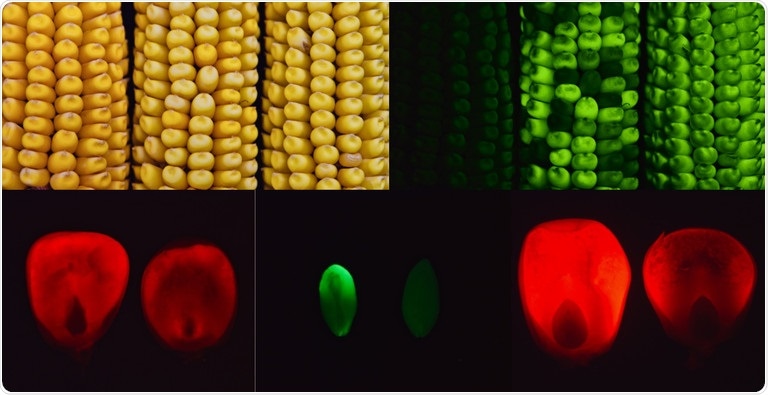An abnormal accumulation of carbohydrates—starches and sugars—in the kernels and leaves of a mutant line of corn can be traced back to a single misregulated gene, and this finding provides insights into how the plant responds to stress.

Fluorescent tagged transgenic corn was used to detect abnormal protein accumulation in mutants. The top left image shows three cobs in bright light, and the top right image shows the same three ears in blue light. The presence and absence of green fluorescence help to easily identify mutant seeds. The bottom images show protein accumulation in control (left) and mutant (right) developing seeds. Image Credit: Debamalya Chatterjee/Penn State.
That is the finding of Penn State researchers who found the Maize ufo1 gene responsible for the mutant corn line in a previous analysis. They are now evaluating the implications and prospects for use in the breeding of new lines of corn that would be more likely to survive in a warming environment.
The discovery of higher sugar levels in plant tissues in their most recent research is only one more factor for plant geneticists to remember.
This discovery has implications for food security and breeding new crop lines that can better deal with a changing climate—with corn, there is still a lot to be done. In fact, there is a great deal of genetic and phenotypic diversity in corn, and we can use that diversity and ask the question, ‘How is the ufo1 gene distributed in the existing 10,000 germplasm lines?’”
Surinder Chopra, Professor, Maize Genetics, College of Agricultural Sciences, Penn State
Will plant geneticists boost corn by selecting for some of the diversity and including the ufo1 gene? That is the question Chopra is attempting to address, beginning with this recent research that discovered increased sugar levels in the mutant corn line’s leaves and seeds.
What characteristics in corn can be enhanced with the help of the ufo1 gene?
Certainly, stress tolerance, but also likely seed development, which has implications in seed yield as well as improved biomass. And we would like to develop a better plant type that could grow in more dense culture, yet still be more productive. And finally, we need to look at resiliency and sustainability. Can we breed corn lines that get the same amount of yield with lower fertilizer inputs and need less water?”
Surinder Chopra, Professor, Maize Genetics, College of Agricultural Sciences, Penn State
Chopra began studying the Maize ufo1 gene due to its correlation with red or orange pigmentation in the mutant corn line. Charles Burnham, a well-known maize geneticist at the University of Minnesota, discovered this notable ufo1 mutant circa 1960.
Another popular maize geneticist, Derek Styles of the University of Victoria in Canada, a former student of Burnham, then selected the tag, which stands for “unstable factor for orange.”
Styles sent Chopra seeds for the mutant line in 1997. Since then, he has introduced the genes into an inbred line retained by his Penn State study community. Chopra solved the evolutionary puzzle of ufo1 in 2019.
However, it has been discovered that the gene regulates certain plant traits other than pigmentation. However, ufo1 is just one gene, and it does not work alone in the corn genome, according to Chopra.
Since the maize plant contains over 30,000 genes, it is critical to understand how ufo1 communicates with other genes before plant geneticists can use it to breed a new kind of seed, he adds.
In order to go to the breeding aspect, we first need to learn how this gene actually functions. We need to learn about how it partners with proteins, and learning about those protein interactions will be the goal of future research.”
Surinder Chopra, Professor, Maize Genetics, College of Agricultural Sciences, Penn State
However, according to Debamalya Chatterjee, a doctoral student in agronomy who pioneered the study, this research demonstrates how the aggregation of sugars in corn seed is changed in the absence or presence of the ufo1 gene.
“Down the road, we could use this knowledge of the ufo1 gene in breeding, to perform better crosses that make more resilient and more productive hybrids, where sugars and starches are in balance,” said Chatterjee.
The research team took a step in that direction on May 3rd, 2021, when they published in Plant Physiology that the maize ufo1 mutant gene influences cell differentiation, hormone, and carbohydrate accumulation in the plant, and modifies expression patterns of important genes that play a role in corn seed development.
Source:
Journal reference:
Chatterjee, D., et al. (2021) Maize unstable factor for orange1 is essential for endosperm development and carbohydrate accumulation. Plant Physiology. doi.org/10.1093/plphys/kiab183.